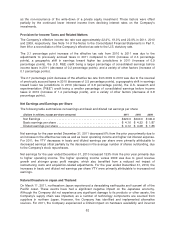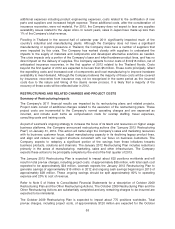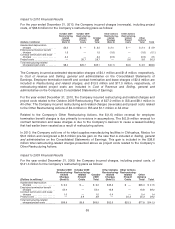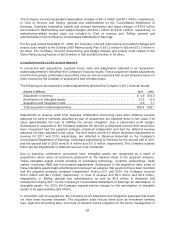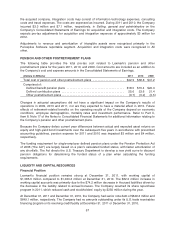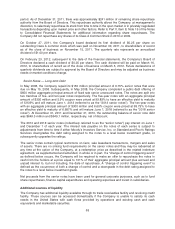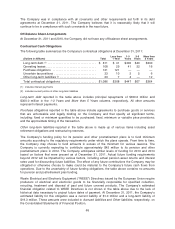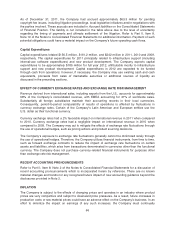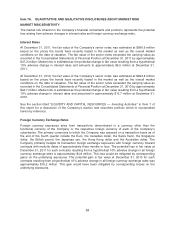Lexmark 2011 Annual Report Download - page 62
Download and view the complete annual report
Please find page 62 of the 2011 Lexmark annual report below. You can navigate through the pages in the report by either clicking on the pages listed below, or by using the keyword search tool below to find specific information within the annual report.
The debt to total capital ratio was stable at 32% at December 31, 2011 and at December 31, 2010. The
debt to total capital ratio is calculated by dividing the Company’s outstanding debt by the sum of its
outstanding debt and total stockholders’ equity.
Liquidity
The following table summarizes the results of the Company’s Consolidated Statements of Cash Flows
for the years indicated:
(Dollars in Millions) 2011 2010 2009
Net cash flows provided by (used for):
Operating activities ......................................... $391.0 $ 520.4 $ 402.2
Investing activities .......................................... (96.9) (630.6) (228.2)
Financing activities ......................................... (272.3) (12.3) 3.8
Effect of exchange rate changes on cash ....................... (3.2) 0.7 2.3
Net increase (decrease) in cash and cash equivalents ............ $ 18.6 $(121.8) $ 180.1
The Company’s primary source of liquidity has been cash generated by operations, which totaled $391
million, $520.4 million, and $402.2 million in 2011, 2010, and 2009, respectively. Cash from operations
generally has been sufficient to allow the Company to fund its working capital needs and finance its
capital expenditures and acquisitions. Management believes that cash provided by operations will
continue to be sufficient on a worldwide basis to meet operating and capital needs as well as the
funding of expected dividends and share repurchases for the next twelve months. However, in the
event that cash from operations is not sufficient, the Company has substantial cash and cash
equivalents and current marketable securities balances and other potential sources of liquidity through
utilization of its trade receivables financing program and revolving credit facility or access to the private
and public debt markets. The Company may choose to use these sources of liquidity from time to time,
including during 2012, to fund strategic acquisitions, dividends, and/or share repurchases.
As of December 31, 2011, the Company held $1,149.4 million in Cash and cash equivalents and
current Marketable securities. The Company’s ability to fund operations from this balance could be
limited by the liquidity in the market as well as possible tax implications of moving proceeds across
jurisdictions. Of this amount, approximately $988.4 million of Cash and cash equivalents and current
Marketable securities were held by foreign subsidiaries. The Company utilizes a variety of financing
strategies with the objective of having its worldwide cash available in the locations where it is needed.
However, if amounts held by foreign subsidiaries were needed to fund operations in the United States
the Company could be required to accrue and pay taxes to repatriate a large portion of these funds.
The Company’s intent is to permanently reinvest undistributed earnings of low tax rate foreign
subsidiaries and current plans do not demonstrate a need to repatriate them to fund operations in the
United States.
As of December 31, 2010, the Company held $1,217.2 million in Cash and cash equivalents and
current Marketable securities. Of this amount, approximately $754.0 million of Cash and cash
equivalents and current Marketable securities were held by foreign subsidiaries.
A discussion of the Company’s additional sources of liquidity is included in the Financing activities
section to follow.
Operating activities
The Company continues to generate significant annual cash flow from operations. After the strong
recovery in earnings and cash flows in 2010 versus 2009, cash-flow from operations in 2011
decreased to $391 million, reflecting higher cash outlays as well as the decline in net earnings.
58






